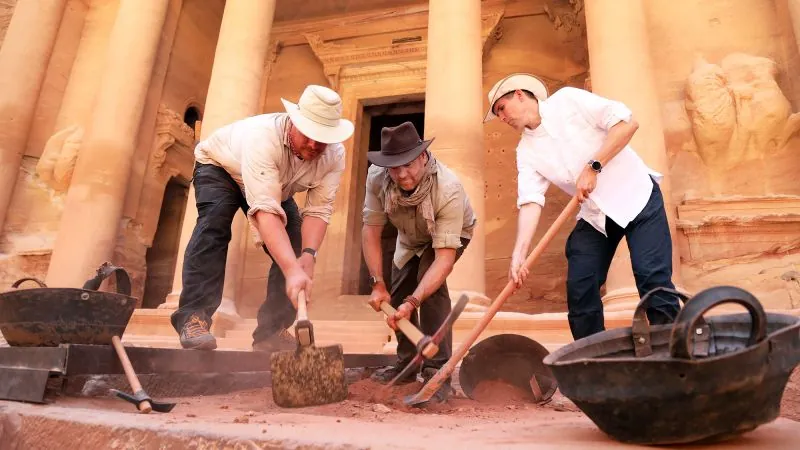
Astonishing Tomb Unearthed Beneath Petra's Iconic Treasury: Secrets of the Nabataeans Revealed!
2024-10-12
Author: Olivia
Groundbreaking Discovery in Petra
In a groundbreaking discovery beneath Petra's famed Khaznah, known as the Treasury, archaeologists have uncovered a tomb containing at least 12 intact human skeletons, alongside ancient artifacts dating back over 2,000 years. This monumental find sheds new light on the enigmatic Nabataeans, an ancient civilization that thrived in the region from the 4th century BC to AD 106.
Excavation Led by Dr. Pearce Paul Creasman
Dr. Pearce Paul Creasman, executive director of the American Center of Research, spearheaded the excavation after utilizing ground-penetrating radar to identify potential undiscovered chambers beneath the Treasury. This modern technology confirmed suspicions of additional burial sites linked to two tombs previously discovered in 2003. With the green light from the Jordanian government, Creasman’s team, supported by Josh Gates of Discovery Channel’s 'Expedition Unknown,' finally embarked on the excavation in August.
Treasure Trove of Artifacts
Despite many tombs in Petra being found either empty or disturbed, this chamber held a treasure trove of skeletal remains and grave goods made from bronze, iron, and ceramics. Gates remarked on the rarity of the find, emphasizing that over two centuries of archaeological work in Petra had not yielded a discovery of this magnitude, underscoring the potential for further secrets hidden beneath one of the world's most iconic archaeological sites.
Insights into Nabataean Society
Petra, celebrated as one of the New Seven Wonders of the World, draws hundreds of thousands of visitors annually, famed for its stunning rock-cut architecture and rich history. The Treasury itself has been the subject of intense historical debate regarding its purpose, with some experts suggesting it functioned as a mausoleum—a notion bolstered by the recent findings.
Remarkable Ceramic Chalice Discovery
Among the artifacts uncovered was a remarkable ceramic chalice, which bore an uncanny resemblance to the legendary Holy Grail, famously featured in the 1989 film 'Indiana Jones and the Last Crusade.' Such correlations between historical artifacts and popular culture excite archaeologists and treasure hunters alike, feeding into the ongoing fascination with petrified relics of the past.
Challenges in Preservation
The preservation of the artifacts was exceptional, but researchers noted that the skeletal remains were more fragile than anticipated, likely due to the humid conditions and seasonal flooding in Petra. Some remains showed signs of mold, indicating the environmental challenges faced in the preservation of ancient human remains. Notably, intact burials of this kind are exceptionally rare, as many previous tombs uncovered in the area suffered disturbance from ancient travelers seeking shelter from the desert elements.
Egalitarian Social Structure?
The mystery surrounding Nabataean burial customs persists, particularly regarding their egalitarian social structure, which appears to be reflected in their burials. While researchers have yet to ascertain whether this recent tomb belonged to members of the royal class or commoners, the discovery provides valuable data for understanding the society's social hierarchies.
DNA Analyses Planned
As research on the skeletons continues, scientists aim to conduct DNA analyses to ascertain familial relationships among the deceased, which could illuminate aspects of Nabataean life, their diets, occupational roles, and cultural practices. Creasman commented on the significance of the location, suggesting that the individuals buried beneath such a prominent site were likely of considerable importance to the ancient city.
Unlocking Further Narratives
The revelations from this tomb hold the potential to unlock further narratives about the Nabataeans and enrich our understanding of one of history’s most fascinating civilizations. Follow us as we delve deeper into the mysteries of Petra and unveil more astonishing discoveries in the days to come!









 Brasil (PT)
Brasil (PT)
 Canada (EN)
Canada (EN)
 Chile (ES)
Chile (ES)
 España (ES)
España (ES)
 France (FR)
France (FR)
 Hong Kong (EN)
Hong Kong (EN)
 Italia (IT)
Italia (IT)
 日本 (JA)
日本 (JA)
 Magyarország (HU)
Magyarország (HU)
 Norge (NO)
Norge (NO)
 Polska (PL)
Polska (PL)
 Schweiz (DE)
Schweiz (DE)
 Singapore (EN)
Singapore (EN)
 Sverige (SV)
Sverige (SV)
 Suomi (FI)
Suomi (FI)
 Türkiye (TR)
Türkiye (TR)